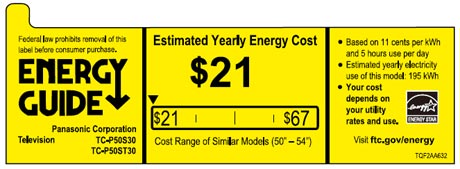Do buyers really care about how much energy HDTVs use?

Over the last couple of years, there's been a lot of talk about reducing power consumption from HDTVs as part of the push to "go green." And thanks to recent Energy Star guidelines and a concerted effort from TV manufacturers, the yearly energy costs for big-screen sets have declined substantially, especially as more energy-efficient LED-backlit LCDs are sold.
Energy Star has even started requiring new TVs to sport a label showing their annual estimated energy cost. And those costs have dropped since Energy Star 4.0 guidelines were introduced in 2010, slashing the power usage required to meet the standards nearly in half. While Energy Star told me that the aggregate energy savings from the new guidelines is substantial -- $2.5 billion annually, with emissions reductions equivalent to taking 3 million cars off the road -- it also admits that "On a unit basis, the extra savings from a 4.0 qualified TV vs a 3.0 TV is relatively small."
In other words, it's great that sets are greener, and maybe a 50-inch plasma today hurts the environment less than a few years ago, but is it a major factor in the buying decision of consumers? An annual energy cost of $50 works out to less than $5 per month in outlay, which just might not matter much when it costs $50 to fill up your car with gas each time you go to the pump.
That may be why TV makers aren't emphasizing LED TVs as cost-saving devices, which DisplaySearch Director of European TV Research Paul Gray has recently argued for. DisplaySearch research shows that the time that an entry-level LED-backlit HDTV would repay for itself is 5.1 years, and Gray says that manufacturers should be exploiting that fact in their marketing, but aren't. (Of course, after five years, you're probably ready for a new TV anyway.)
While DisplaySearch has also found that interest in low-energy consumption is a far more important buying consideration in a new HDTV than 3D capability, maybe manufacturers have a reason for not hyping power savings more. That's despite the fact that LED sets are still pricier than fluorescent-tube-backlit LCDs, presumably giving makers more incentive to push them.
It may just be a case of consumers saying that want to consider energy consumption as part of the buying process, but then purchasing the set they think has the best picture, or the price in line with their budget. It's not dissimilar to someone saying they should buy a Prius, but buying another car because it has more room or a lower monthly payment.
Do you think that energy savings is truly an important consideration for buying a new HDTVs? Or do "going green" concerns fly out the window when you find the set you want? Let us know in the Comments section.
